ERNA: The software for your corporate strategy
Use the Double Materiality Analysis to make your company successful in the long term.
Success through sustainability
Sustainability is no longer a nice-to-have, but is crucial for corporate success.
But which topics hold risks, which hold opportunities and how do these affect your business strategy?
That’s why we developed ERNA: Our software systematically guides you through the Double Materiality Analysis process according to CSRD and helps you set the right priorities – transparently and process-oriented. Because only those who can classify topics based on their sustainability relevance and understand the connections can position their company resiliently.
Transform sustainability from a compliance task into a competitive adventage. Discover how systematic sustainability assessment makes your company more successful and resilient – for a future in which success and sustainability are inextricably linked
Guided process
Systematic recording and analysis of all company topics – structured, complete, and traceable.
Flexible visualization
Your analysis results as a list, chart or diagram – complete or filtered according to criteria.
Connect knowledge
Combine individual findings into a complete picture. The whole is more than the sum of its parts.
Short, medium and long term: Sustainable success with ERNA
Sustainability offers measurable business results in all business areas:
From regulatory compliance and cost savings to strategic future viability.
Secure your free consultation appointment.
Develop the basis for future-proof strategies...
Reduction of capital costs
and better information basis
Improve access to ESG information for investors and capital providers with a transparent data foundation to receive better conditions.
Successful employee recruitment
and retention
Inspire qualified specialists for your company and strengthen the long-term loyalty of valuable employees.

More efficient processes
and resource utilization
Achieve more with less effort through lean processes and a sustainable, optimized utilization of your company resources.
Stronger market positioning
and customer loyalty
Gain a competitive edge and build loyal customer relationships through targeted measures.
Future-proof business models
and markets
Tap into new market potential with data-based decisions and develop viable business models for sustainable growth.
Basis for ESG Reporting aligned with CSRD /ESRS
Use the analysis results as a structured, auditable entry point for your sustainability reporting.
And this is how it works...
Double Materiality Analysis as a starting point
ERNA is based on the proven methodology of the Double Materiality Analysis. With the software, you view all strategic topics from two perspectives:
- The impact of your company on the environment and society and
- The financial implications of these topics for your company.
Stakeholder perspectives are flexibly integrated into the process.


Prioritized fields of action
The result: A clear overview of which ESG topics are truly relevant for your company.
You create a prioritized list of concrete fields of action as the basis for your corporate development and the strategy for business resiliance.
From analysis to sustainable strategy
Use these findings to align your corporate strategy effectively, future-proof and sustainably. Manage identified risks and leverage your opportunities.
This creates a reliable basis for informed decisions, transparent reporting, and long-term corporate success.

Everything in view at all times
Within the dashboard, you will find a visualization of the entire process. There, you can always check which step you are currently in.

Integrated stakeholder assignment
Assign identified relevant topics to a list of suggested stakeholders which you can individually expand and adapt as needed.
Integrated documentation
The software is designed to allow traceability of results so that the DMA process can be varified externally. Onmitted data-fields are automatically flagged.
Made in Germany
German software quality: Developed, hosted and supported in Germany with the highest standards for security, reliability and data protection
Arrange a free consultation appointment now
We support you from the very beginning – with experience, structure and foresight.
Build the foundation today for a corporate strategy that can provide your company with long-term stability and success.
Analysis process workflow
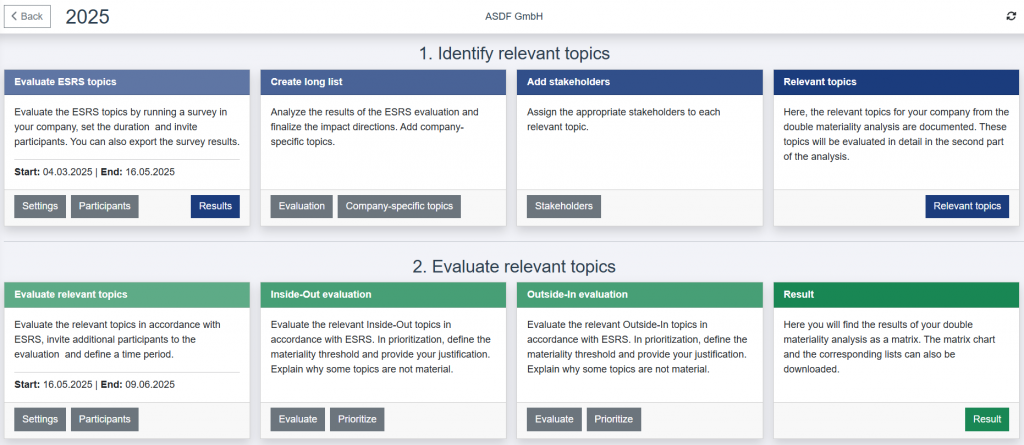
Select relevant topics: Filter based on the ESRS topics that are relevant for your company. You can manually add your own topics – such as finincial or governance topics. After assigning the associated stakeholders to each relevant topic, you receive your Long List – a list of your relevant sustainability topics including all recorded information regarding
- Direction of impact
- Time horizon of impact
- Value chain
- Associated stakeholders
Assessment of relevant topics: Evaluate what impact your company has on the environment, society and the economy (Inside-Out) as well as the opportunities and risks that arise conversely for your business model (Outside-In).
After defining a threshold value, you receive all material topics, prioritized in 6 different types of result presentation. The data obtained are of significant importance for your corporate strategy and can additionally be used for CSRD-compliant sustainability reporting.
Consider topics from different perspectives
Internal Expertise: Both assessments can be carried out by sustainability officers as well as jointly with employees and experts from various company departments.
Double Materiality: Through the dual analysis of relevant topics, you can transparently trace the short, medium and long-term impacts your company has on the environment, economy and society (Inside-Out perspective) and recognize the opportunities and risks that arise from the reverse direction of impact (Outside-In perspective).
This is how you create a holistic basis for your corporate strategy, data-based and ESRS-compliant.
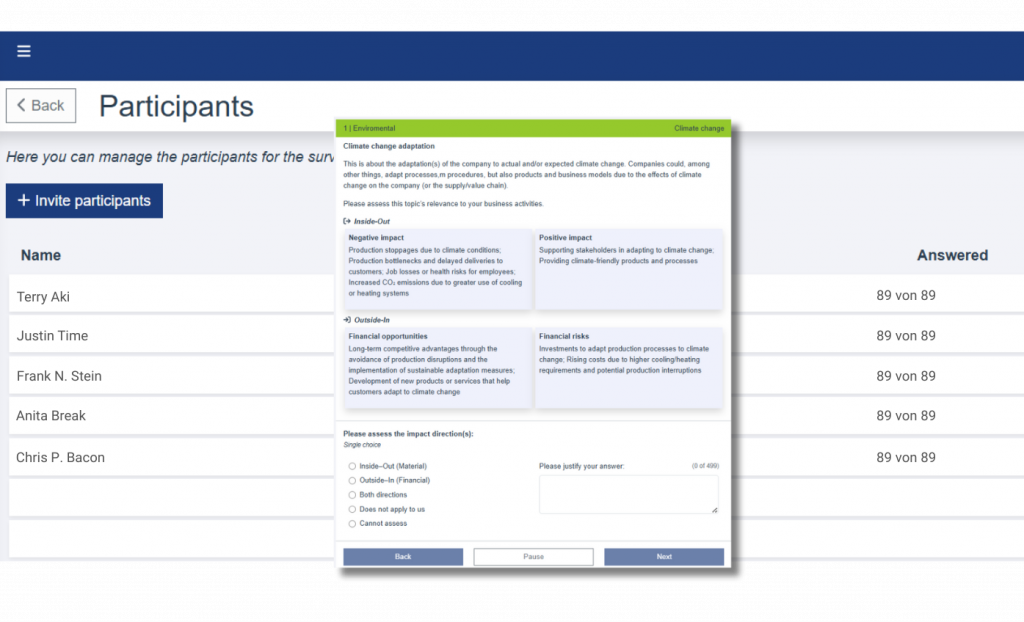
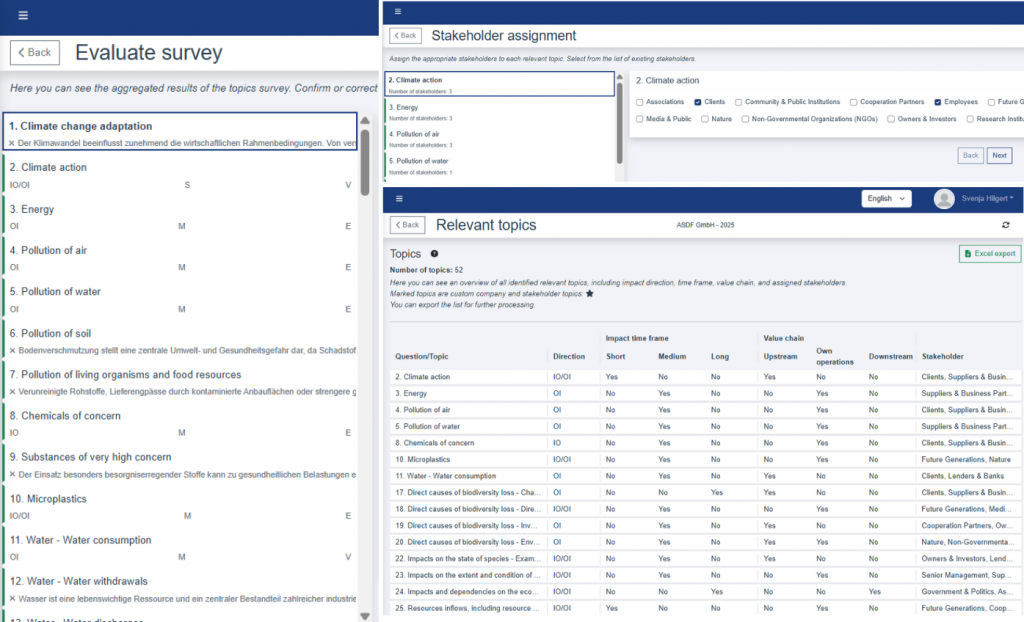
Identify relevant topics
Decide independently or confirm and correct the assessments of your employees regarding
- Direction of impact
- Time horizon of impact
- Value chain.
Then assign the appropriate stakeholders to each relevant topic.
The result is a clear list of all identified relevant topics including direction of impact, time horizon of impact, value chain and stakeholders: Your Long List
Identify relevant topics
In the next level of assessment, the Long List topics are examined regarding their actual and potential impacts on the environment, society and the economy. This includes scale, scope, remediability and likelihood (Inside-Out Perspective).
Changing the perspective, evaluations are made regarding the effects of sustainability topics on the company (Outside-In Perspective), identifying financial risks and opportunities.
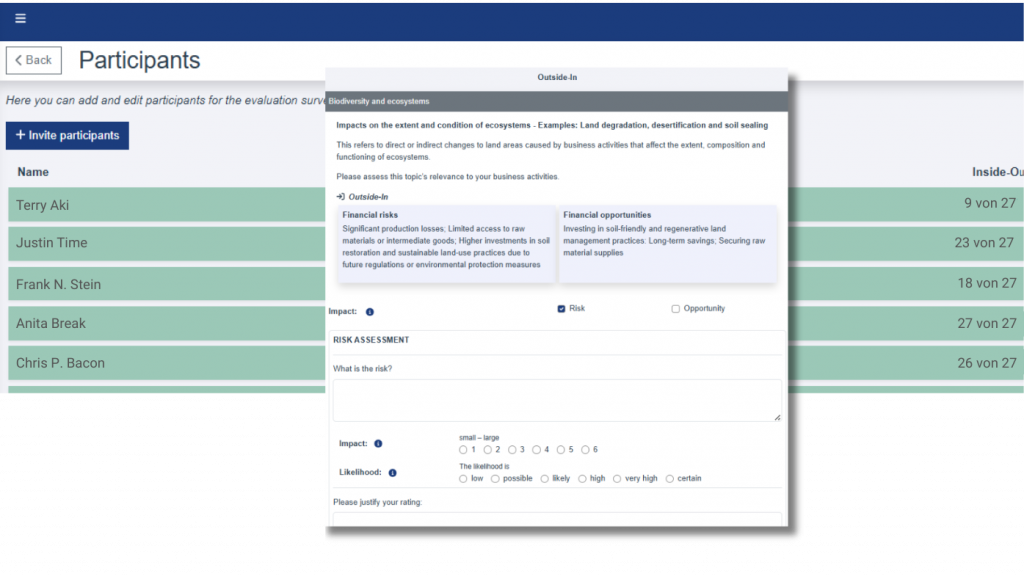
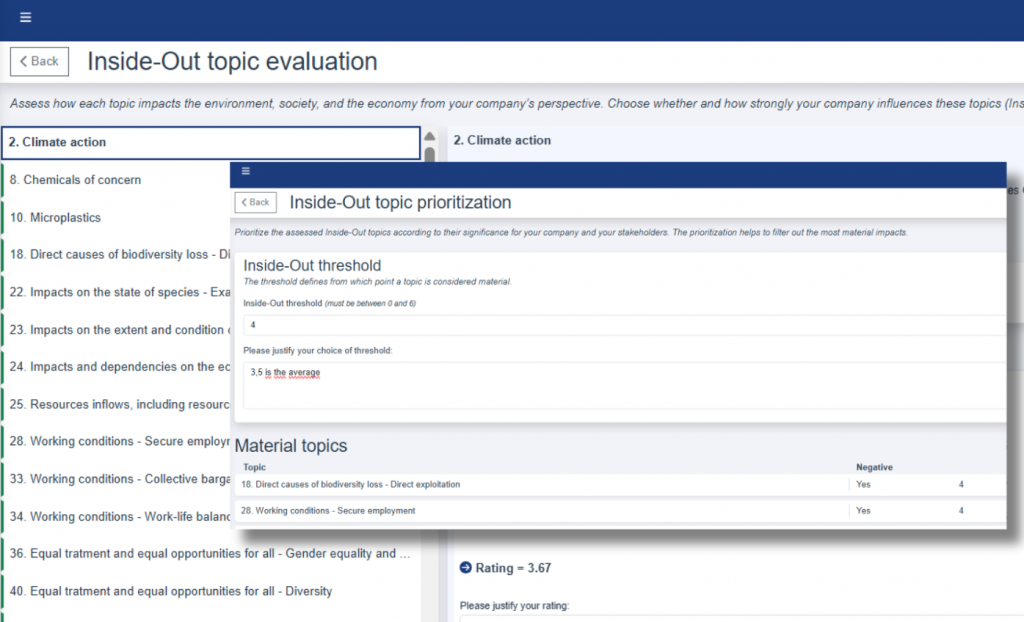
Define material topics
Define which topics are material for your company by using threshold values. These threshold values serve as a filter for the relevance score that the software automatically generated for each Long List topic based on the results of the second assessment.
The result: The well-founded basis for your corporate strategy
At the end of the analysis process, you receive both graphical and tabular representations of your results.
The information gained forms the foundation of your sustainable corporate strategy, transparent, traceable and audit-proof in the case of sustainability reporting.
All material topics are presented in a 3×3 matrix, classified according to
- Impact: Positive, negative, both
- Effect: Opportunity, risk, both
- Strategic relevance
Color assignment of tiles
- Red: High strategic relevance
- Yellow: Medium relevance
- Green: Lower but noteworthy relevance
The numbers represent the respective IDs of the sustainability topics.
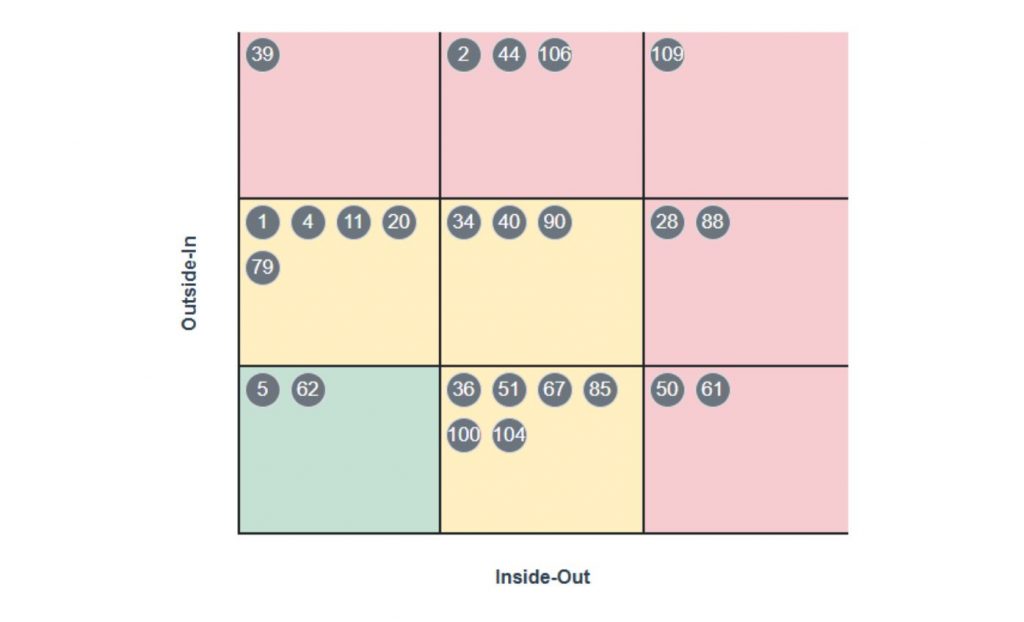

Furthermore two Tornado diagrams contrast the results of the
- Inside-Out Analysis: Positive and negative impacts and the
- Outside-In Analysis: Opportunities and risks
for all material topics. This allows you to recognize at a glance where is the greatest potential for your corporate strategy.
It is possible to filter results by hiding individual aspects or displaying specific matrices in the form of bubble diagrams.
More detailed information is available in the associated tables
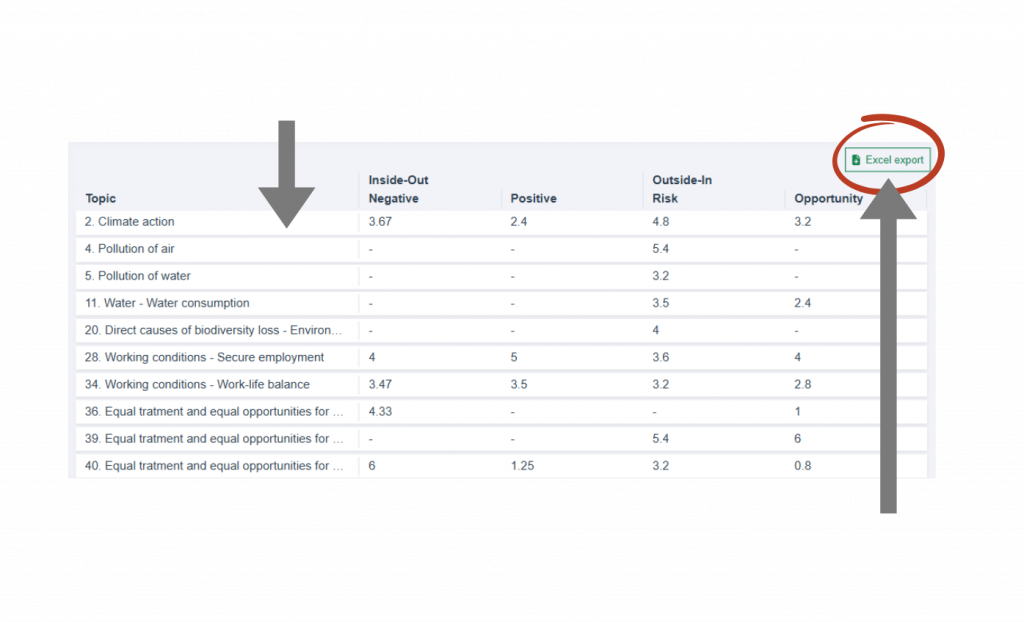
You can find the table directly below your results matrix.
In addition, an immediately exportable Excel file containing all results of the Double Materiality Analysis is ready for you.
Start now without obligation
We help you make sustainability tangible and actionable.
Discover how sustainability becomes a driver for growth – individually, practically oriented and strategically.
Frequently asked questions
What is a Double Materiality Analysis and how long does it take to carry one out?
To systematically capture all sustainability topics relevant to your company, the Double Materiality Analysis combines two directions of impact: the Impact perspective with the Financial perspective.
- Inside-Out: What actual and potential impacts does your company have on the environment, society and the economy?
- Outside-In: What external risks and opportunities could influence your business model?
Companies require six months or more to carry out the initial materiality analysis without structured help. With our software, you shorten the process to a few weeks or days.
What is the difference between relevant and material topics?
Relevant topics are significant to the company and/or its stakeholders.
Material topics are those where your organisation has a significant impact on the natural environment, society or your own people and/or economic issues. Material for your business are also ESG topics that have a negativ or positive effect on your company (financial risks and opportunities).
I am not subject to reporting requirements, why should I conduct a Double Materiality Analysis?
Even without a legal reporting obligation, the Double Materiality Analysis offers valuable strategic added value. It shows you which sustainability topics are business-relevant for your company and what expectations stakeholders such as customers, employees or investors have. This allows you to make informed decisions, strengthen your future viability and position yourself early as a responsible and future-oriented company.
How does the software help me with my corporate strategy?
The software provides you with a well-founded data basis to align your corporate strategy in a targeted and future-proof manner. You recognize which topics are of high significance for your company – both in terms of business impact and stakeholder expectations. This allows you to strategically derive priorities, specifically evaluate risks and opportunities and deploy your resources where they will make the biggest difference in the long term.
Is the software suitable for my company at all?
Yes, because just like the CSRD questionnaire, the ERNA software is usable across all industries.
What prior knowledge is necessary?
Technical prior knowledge is not necessary, as you are guided step-by-step through the analysis process. A certain level of operational experience within the company is recommended to carry out the assessments conscientiously.
How does the software help with the creation of my sustainability report?
Our software not only provides a systematic process for Double Materiality Analysis (DMA) but also presents the results in easy to use formats in a well documented way. This creates a basis for strategy development as well as for sustainability reporting according to CSRD / ESRS as well as other formats.
CSRD, ESRS, VSME and ESG, what do they mean?
CSRD: Corporate Sustainability Reporting Directive – EU directive for mandatory sustainability reporting for large and medium-sized companies
ESRS: European Sustainability Reporting Standards – EU standards for sustainability reporting according to CSRD
VSME: Voluntary Sustainability Reporting Standard for non-listed small and medium sized enterprises – Voluntary sustainability reporting standard for non-listed small and medium-sized companies
ESG: Environmental, Social, Governance
